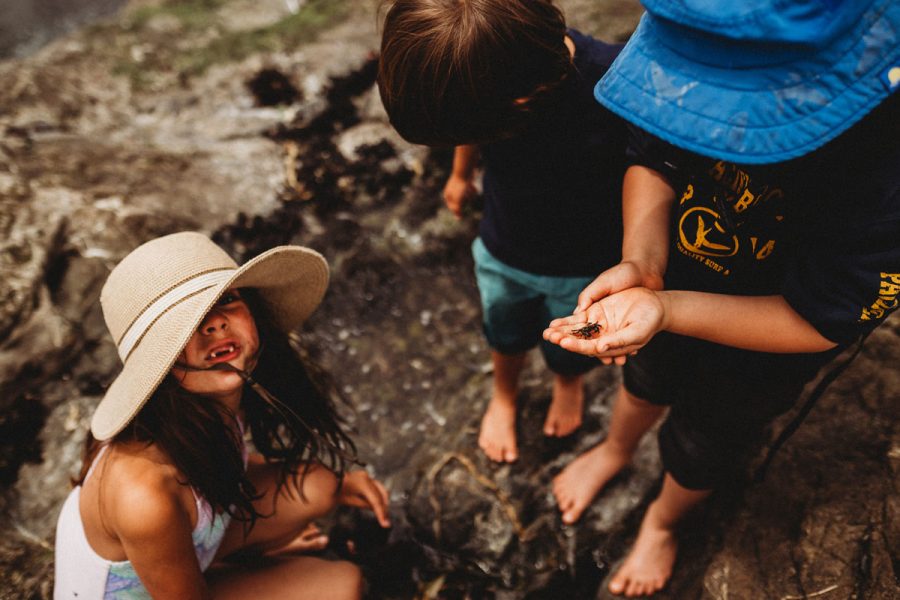

“Who wants to go to the beach?” In our family, this question is almost always answered with, “Me!” During the summer, we pack up our beach buggy, a large cart that holds just about everything, and spend the day with our toes in the sand or surf. With the advancing heat in the upper Sacramento River Valley, your family may also be saying, “Me too!” and packing up for a cool day at the coast.
My curious children plus multiple hours spent oceanside led to many inquiries about their surroundings. I often have no idea about the answers, and I end up pleading ignorance. My daughter asked me once, “Do you know anything about the beach and ocean?”
So, I created this list of questions and answers about the beach, and I have created this list of “Kid’s Beach Questions Answered.” Now you will know the correct responses and hopefully prevent your children from wondering if you passed high school science. For the record, I got an A in my biology class. Besides helping you appear smart to your children, you can also use this list to create a trivia game.
Why does it sound like the ocean when you hold a shell up to your ear?
It’s actually the sound of your own ear fluid being echoed back to you.
How are seashells made?
One common type of seashell is the one found on clams. To create the shell, the clam takes in salt and chemicals from the ocean water. The clam uses these materials to produce calcium carbonate, which is secreted on the outside of their bodies and hardens to create a shell.
How is sea glass made?
Sea glass is the result of people discarding glass into the ocean. It can take decades before the glass becomes smooth. This smoothing process is a result of the glass being tossed around by the ocean waves and dragged against the sand.
Is sea glass worth money?
It can be. Like gems, it depends on different factors such as color and shape. One piece of sea glass has sold for more than $1,000.
What is the most common color of sea glass?
The most common colors of sea glass are white, green and brown.
What is the rarest color of sea glass?
The rarest colors of sea glass are red, orange and yellow.
Are there different types of seagulls?
What most people refer to as a seagull is a herring gull. The herring gull can differ in size and color depending on the age. Adults are mostly white with a gray back. Juvenile herring gulls are brown. These types of birds are scavengers and are usually found near food. There is also another type of gull called the great black-backed gull which is found along the coasts and looks similar to the herring gull. This bird is the largest gull in the world. There are two dozen different species of gulls living in North America.
How can the seagull drink the seawater?
The seagull has special glands in their eyes that allow them to excrete the salt.
Do seagulls have nests and lay eggs?
Yes, seagulls lay eggs and have nests. Seagulls often place the nest near a rock, log or bush to protect it from predators and strong wind.
Is a starfish a fish?
It is actually called a sea star and is not a starfish. Sea stars do not have fins or gills found on fish. This type of creature is an Echinodermata in the same category as a sand dollar, sea urchin and sea cucumber. A fun fact about sea stars is that they can regenerate an arm.
Why do the tides change?
Tide change is caused by the gravitational pull of the sun and moon as well as the Earth’s rotation.
How do people know the times of low and high tides?
Creating a tide chart with times of high and low tide is not an exact science. Factors such as ocean current, winds and the contour of the ocean bottom can all influence what time high and low tide will occur. The official source in the United States for predicting tides is the Center for Operational Oceanographic Products and Services (CO-OPS). There are 140 tide stations that measure tide levels, wind speed and direction, water current speed and directions, air and water temperatures and barometric pressure. These measurements collected together create the tidal chart times.
What causes ocean waves?
Waves are the result of winds moving over the ocean surface. The friction between the air and the water transfers the energy between air and water. The transfer of energy is what creates the wave.
How is sand on the beach created?
Sand is created mostly of quartz rocks. The rocks were broken down by wind and rain and then transported to the beach by the water.
What causes an ocean sandbar?
An ocean sandbar is created by waves pulling the sand further into the ocean. When there is a storm or large waves, a sandbar can form farther from the shoreline. Many large waves or storms can form a barrier island.
How to Encourage Your Future Marine Biologist
If your children are interested in marine biology and ecology, you can go to your local library and borrow books on the topic. There are also books about conducting science experiments or identifying different types of ocean organisms. Our favorite books are related to beach combing.
What questions do your kids ask you when you are at the beach?
You can see this article featured in our July 2020 Digital Edition.


Posted in: Out & About
Comment Policy: All viewpoints are welcome, but comments should remain relevant. Personal attacks, profanity, and aggressive behavior are not allowed. No spam, advertising, or promoting of products/services. Please, only use your real name and limit the amount of links submitted in your comment.
You Might Also Like...

2018 Harvest Happenings
This Year’s Events As fall settles in, do you have a hankering for hayrides? Do your kids have a penchant for pumpkin picking? Does your family have a fancy for […]

R-Ranch – An Ultimate Family Outdoor Vacation
Nothing can bring a family together like vacationing in the great outdoors, where each member can enjoy space and time to enjoy camping, hiking, fishing, swimming, taking a horseback ride, […]

Preserving the Past for Future Generations
6 North State Historical Societies Tehama County Museum Launching its first website Tucked away in the Northern California Sacramento Valley, surrounded by mountains and an abundant agricultural community, the Tehama […]
Tearing Up The Track: BMX Racing is Competitive Fun
When BMX racers Evan Enserro and Samantha Heil close their eyes, they dream of the roar of the crowd as they compete in worldwide events, such as the BMX World […]


